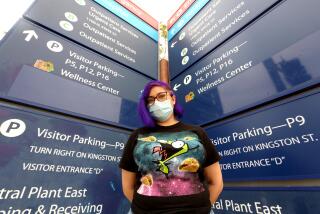Hospital Shuts Its Emergency Room; ‘Ripple Effect’ Feared
- Share via
Officials at a busy downtown hospital that has long been “an open door to the poor masses of Central Los Angeles” announced Monday the closure of its emergency room to paramedic rescue ambulances.
The move by California Medical Center, designed to save money, came as a major blow to the county’s emergency care network. Health officials said they fear a domino effect leading to similar shutdowns at other hospitals and creating havoc in the ambulance rescue system.
About 24,000 patients a year have been treated in the emergency room of the nonprofit medical center at 1414 S. Hope St., the third-oldest hospital in the county, founded in 1887. But effective June 1, the emergency room will be downgraded to “standby” status, meaning that doctors will be on call, rather than on the premises. Walk-in patients will continue to be seen, but ambulances will be diverted to other hospitals.
‘Already at Maximum’
The center’s emergency room has been receiving more rescue ambulance patients--about 10,000 a year--than any private hospital in the county. The bulk of these patients will be rerouted to the two closest county hospitals, County-USC Medical Center and Martin Luther King Jr./Drew Medical Center, which are “already at maximum,” Los Angeles County health official Virginia Price Hastings said.
Some of the spillover will fall onto a few small, private hospitals in the downtown area “which are very nervous” because they cannot handle the load, she said. These are the Hospital of the Good Samaritan, French Hospital of Los Angeles, Queen of Angels Medical Center and Hollywood Presbyterian Medical Center.
Battalion Chief Alan Cowen, in charge of the Los Angeles Fire Department paramedics, predicted that “the quality of patient care will go down” and ambulance response times will increase.
The curtailment of the medical center’s emergency room was prompted by the hospital’s financial losses, amounting to $2.6 million last year, hospital officials said. They figured losses of $500,000 a month in the emergency room, where hundreds of indigent people have sought care and must, by law, be treated and stabilized before discharge.
Adding to the hospital’s burden is its $60-million debt from a recent building campaign, which included construction of a nine-story modern medical tower.
Hospital President William F. Haug said the debt had “an impact on every program in the hospital” but added that the main reason for the emergency room curtailment is “the disproportionate number of government-sponsored patients and level of uncompensated care that we provide.”
Financing of health care for indigent patients has become a major health-care issue in recent years, as increasing numbers of hospitals find that they lack the resources to foot the bill.
Fifteen hospitals in Los Angeles County have closed or curtailed their emergency rooms during the last two years, said David Langness, an official with the Hospital Council of Southern California.
Because of its size and location, the move by California Medical Center is the worst blow to date.
“It’s a sad requiem for an inner-city hospital that has such a long tradition of serving the poor,” Langness said.
Langness predicted that the move will have a “massive ripple effect” on the rest of the area’s ailing emergency network.
“If there is a domino effect, it would indeed be catastrophic,” said Allene Nungesser, head of Hollywood Presbyterian Medical Center. She said she expects Hollywood Presbyterian will take some of the spillover of patients from California. She said “pivotal decisions” will be made during the next few weeks by county and state officials either “to backstop” the system, or let it collapse.
Hospital officials say the emergency care network--including the trauma system--has been suffering from a severe funding crunch. Two years ago, California Medical Center was the first hospital to close its trauma center. Six more have dropped out since then, leaving only 16 centers.
More to Read
Sign up for Essential California
The most important California stories and recommendations in your inbox every morning.
You may occasionally receive promotional content from the Los Angeles Times.










